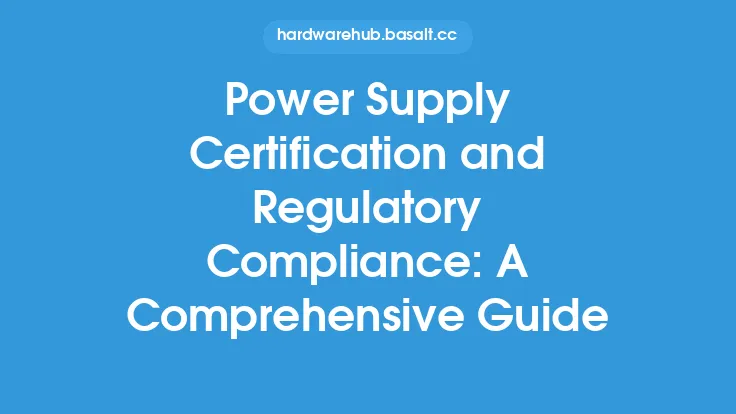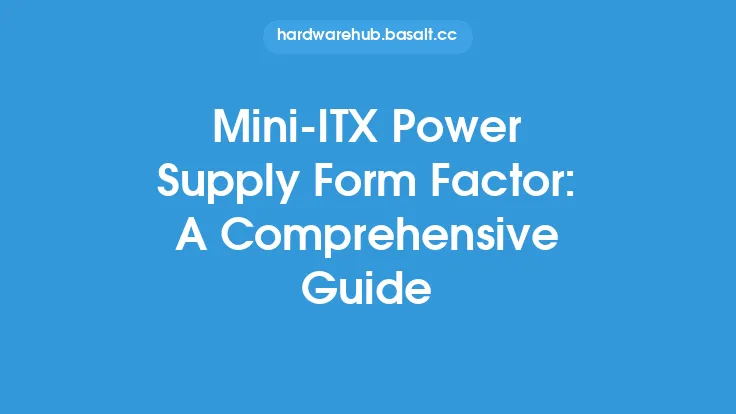Power supply efficiency is a critical aspect of any electronic system, including computers, data centers, and other devices that rely on a stable and efficient power supply. At its core, power supply efficiency refers to the ability of a power supply unit (PSU) to convert the input power from the mains to the required output power with minimal loss of energy. In this article, we will delve into the world of power supply efficiency, exploring the key concepts, technologies, and factors that influence the efficiency of a PSU.
Introduction to Power Supply Efficiency
Power supply efficiency is typically measured by the ratio of the output power to the input power, expressed as a percentage. This is known as the efficiency rating of the PSU. For example, a PSU with an efficiency rating of 80% means that for every 100 watts of input power, the PSU can deliver 80 watts of output power, with the remaining 20 watts being lost as heat. The efficiency rating of a PSU is influenced by several factors, including the design of the PSU, the quality of the components used, and the operating conditions.
Types of Power Supply Efficiency
There are several types of power supply efficiency, each with its own set of characteristics and applications. The most common types of power supply efficiency include:
- Linear power supply efficiency: This type of efficiency is achieved through the use of linear regulators, which convert the input voltage to the required output voltage using a series of resistive elements.
- Switching power supply efficiency: This type of efficiency is achieved through the use of switching regulators, which convert the input voltage to the required output voltage using high-frequency switching elements.
- Resonant power supply efficiency: This type of efficiency is achieved through the use of resonant converters, which convert the input voltage to the required output voltage using resonant circuits.
Factors Influencing Power Supply Efficiency
Several factors can influence the efficiency of a PSU, including:
- Component quality: The quality of the components used in the PSU, such as capacitors, inductors, and MOSFETs, can significantly impact the efficiency of the PSU.
- Design and topology: The design and topology of the PSU, including the choice of regulator type and the layout of the components, can also impact the efficiency of the PSU.
- Operating conditions: The operating conditions of the PSU, including the input voltage, output current, and ambient temperature, can also impact the efficiency of the PSU.
- Load profile: The load profile of the PSU, including the type and number of devices being powered, can also impact the efficiency of the PSU.
Power Supply Efficiency Metrics
Several metrics are used to measure the efficiency of a PSU, including:
- Efficiency rating: This is the most common metric used to measure the efficiency of a PSU, expressed as a percentage.
- Power factor: This metric measures the ratio of the real power to the apparent power, with a higher power factor indicating a more efficient PSU.
- Total harmonic distortion (THD): This metric measures the distortion of the output voltage waveform, with a lower THD indicating a more efficient PSU.
- Mean time between failures (MTBF): This metric measures the reliability of the PSU, with a higher MTBF indicating a more reliable PSU.
Power Supply Efficiency Technologies
Several technologies are used to improve the efficiency of PSUs, including:
- Active power factor correction (APFC): This technology uses active components to correct the power factor of the PSU, resulting in a more efficient and reliable operation.
- Synchronous rectification: This technology uses synchronous rectifiers to improve the efficiency of the PSU, resulting in a more efficient and reliable operation.
- Soft switching: This technology uses soft switching techniques to reduce the switching losses in the PSU, resulting in a more efficient and reliable operation.
- Digital power management: This technology uses digital control and monitoring to optimize the performance of the PSU, resulting in a more efficient and reliable operation.
Power Supply Efficiency Testing and Certification
PSUs are tested and certified to ensure that they meet certain efficiency standards, including:
- 80 PLUS certification: This certification program tests the efficiency of PSUs at different loads and certifies them based on their efficiency rating.
- Energy Star certification: This certification program tests the energy efficiency of PSUs and certifies them based on their energy efficiency rating.
- Eco-mode certification: This certification program tests the eco-friendliness of PSUs and certifies them based on their eco-friendliness rating.
Conclusion
In conclusion, power supply efficiency is a critical aspect of any electronic system, and understanding the key concepts, technologies, and factors that influence the efficiency of a PSU is essential for designing and building efficient and reliable systems. By using high-efficiency PSUs and optimizing the design and operation of the system, it is possible to reduce energy consumption, minimize heat generation, and improve the overall performance and reliability of the system. As technology continues to evolve, it is likely that new and innovative technologies will emerge to further improve the efficiency of PSUs, enabling the development of even more efficient and reliable electronic systems.





